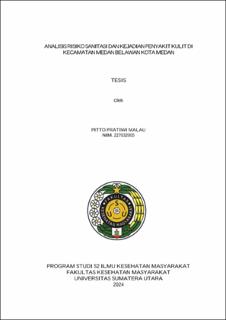| dc.description.abstract | Skin diseases are included in the list of the ten largest disease cases in Medan Belawan district, which is 1,751 cases with a percentage of 24%. When viewed from the coverage of basic sanitation in households is not evenly distributed and some basic sanitation such as family toilets, wastewater sewers have not met sanitation standards. Poor sanitation conditions will have the potential to become a medium for disease transmission, especially environment-based diseases such as skin diseases. This study aims to analyze sanitation risks with the incidence of skin diseases. The population consists of 27,114 households with a sample size of 100 households. Data collected through interviews using questionnaire instruments will then be calculated using the Sanitation Risk Index calculation formula so that a score will be obtained that will state the sanitation risk. To see the relationship between sanitation and the incidence of skin diseases, a statistical analysis of chi square was used. Multivariate analysis uses multiple logistic regression analysis.
Based on the calculation of the sanitation risk index, two very high risk categories were obtained, namely household waste management variables (77) and SPAL (67), two variables were in the medium risk category, namely dirty water/fecal waste
disposal (42) and sanitary hygiene behavior (48) and drinking water and clean water source management with the less risk category (24). The results showed a relationship between age (p-value=0.036), occupation (p-value=0.037), household
waste treatment (p-value=0.047), sewage disposal/latrines (p-value=0.027), wastewater sewers (p-value=0.028), clean water sources and drinking water treatment (p-value=0.045) and sanitary hygiene behavior (p-value=0.016). The most dominant variable in this study was the disposal of dirty water/fecal waste (p-value=0.002) Ex B = 5.927. The six variables have a probability value of 98 percent for the incidence of skin diseases. It is recommended for the local government, especially the Medan City Health Office, to increase the use and procurement of decent latrines in households. | en_US |


